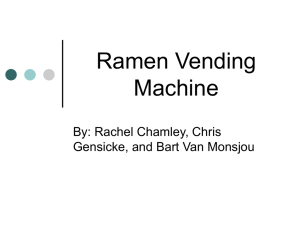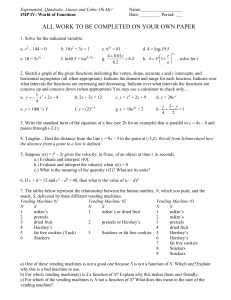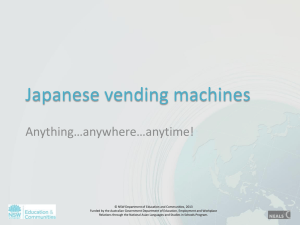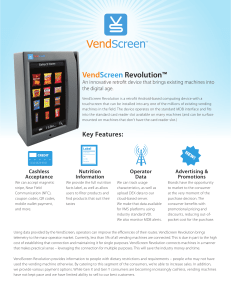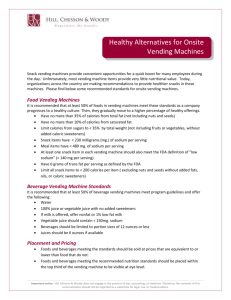Pamphlet 2 - Healthy vending machines
advertisement
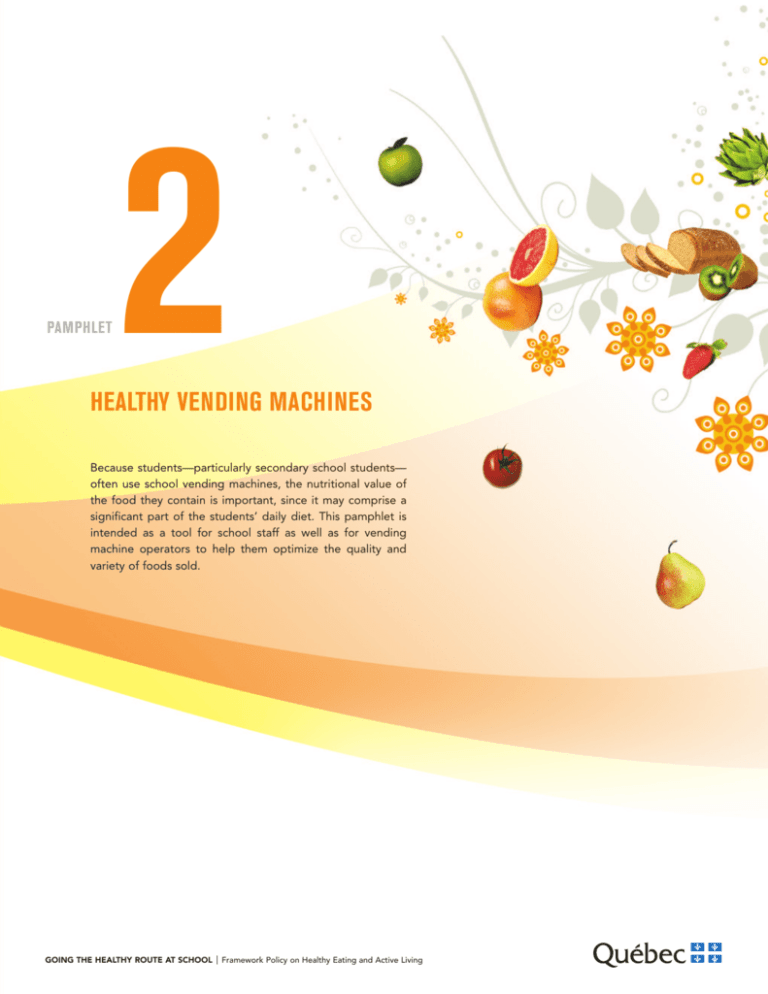
PAMPHLET 2 HEALTHY VENDING MACHINES Because students—particularly secondary school students— often use school vending machines, the nutritional value of the food they contain is important, since it may comprise a significant part of the students’ daily diet. This pamphlet is intended as a tool for school staff as well as for vending machine operators to help them optimize the quality and variety of foods sold. GOING THE HEALTHY ROUTE AT SCHOOL Framework Policy on Healthy Eating and Active Living GENERAL GUIDELINES > Eliminate the sale of all products where sugar is the first ingredient listed (e.g. candy bars, candies, chocolate- or yogurt-covered dried fruit, chocolate- or sugar-coated fruit snacks, chocolate with less than 70% cocoa). > Vary the contents of vending machines from time to time to prevent students from buying junk food outside the school. BEVERAGE VENDING MACHINES > Eliminate sugar-sweetened and artificially sweetened (diet) soft drinks from vending machines and replace them with a wide selection of 100% pure (unsweetened) fruit juices, vegetable juices, milk and water. > Replace sugar-sweetened beverages (e.g. fruit cocktail, punch or drinks, sports drinks, energy drinks) with 100% pure (unsweetened) fruit juices, vegetable juices, milk and water. > As much as possible, all drink sizes should be lower than 384 ml, and with resealable containers so that students can regulate their consumption as needed. > Limit the availability of caffeinated beverages to areas reserved for school staff. > Although there are a number of milk-based drinks on the market, many contain sugar. Offer only flavoured milks with less than 30 grams of total sugars per 250 ml. It is often difficult to evaluate the nutritional value of foods sold in vending machines. Many schools have therefore turned to the Fuel to Xcell Healthy Vending Machine Program 1 in order to establish a rating system that can be used to differentiate items that may be offered in vending machines from those that should be eliminated. The proposed classification system was developed on the basis of the document named above, and is intended as a suggestion. It should be noted that this system does not take the salt content of foods into account and that, when possible, it is preferable to go with versions with less salt. Finally, it is also suggested that the services of a nutritionist be provided, in order to set up the food classification system or, at least, to approve it. It is up to each school to adopt the strategy best suited to provide healthy food choices from vending machines. CLASSIFICATION A set of criteria can be used to identify unacceptable items that should be eliminated from vending machines, and to categorize acceptable items using a colour-coded system. > Food and beverages classified as green or yellow are products with good nutritional value and are preferred choices for vending machines. Green category items should be chosen most often. > In addition to water, offer nutritious choices such as 100% pure (unsweetened) fruit juices, vegetable juices, milk, yogurt drinks, as well as milk beverages (containing less than 30 grams of sugar per 250 ml) and rice and soymilk beverages fortified with calcium and vitamin D. > White category items should only be consumed occa- sionally. These foods should account for no more than 25% of the content of vending machines. The school could also decide to eliminate these products and to stick to products identified by green or yellow codes. FOOD VENDING MACHINES Food vending machines in schools are usually unrefrigerated. We recommend installing refrigerated units so that students can have access to a wider selection of healthy foods (e.g. raw vegetables, fresh fruit, homemade sandwiches, mixed salads, cheese, milk, yogurt and juice) when food services are not available. Certain foods offer excellent nutritional value and are therefore categorized as green: In order to ensure consistency in the entire range of food offered (cafeteria, caterers, vending machines, food counters, etc.), it is important to respect the principles established for the menu (see Pamphlet 1, Healthy School Menus). All other items (e.g. dried fruit snacks, unsweetened fruit purée, rice cakes, cereal bars) may be evaluated using the checklist on the next page. Please note that the criteria are valid for all foods with a Nutrition Facts Table on the package. > > > > Fresh vegetables and fruit Nuts, seeds and legume snacks, with or without dried fruit Yogurt and yogurt drinks Cheese Remember to comply with school guidelines concerning food allergies. 1. Fuel to Xcell Healthy Vending Machine Program, Ottawa Public Health, December 2004. 2 GOING THE HEALTHY ROUTE AT SCHOOL Pamphlet 2 — Healthy Vending Machines EVALUATION CHECKLIST Product name: Package size: Using the Nutrition Facts Table and the list of ingredients on the package, complete the following checklist: Criteria per vended package Total fat Saturated and trans fats Fibre Sugars Point allocation 3.0 g or less 3 3.1 g to 6.0 g 2 6.1 g to 8.0 g 1 8.1 g to 9.0 g 0 9.1 g to 11.0 g -1 Greater than 11.0 g -10 1.4 g or less 5 1.5 g to 2.0 g 4 2.1 g to 2.5 g 3 2.6 g to 3.0 g 2 3.1 g to 3.5 g 1 3.6 g to 5.0 g 0 Greater than 5.0 g -1 6.0 g or less 4 4.0 g to 5.9 g 3 2.0 g to 3.9 g 2 1.0 g to 1.9 g 1 0 to 0.9 g -2 Sugar is the first -15 ingredient listed Sugar is the second or -3 third ingredient listed Sugar is not among the 0 first three ingredients listed Points TOTAL PRODUCT CLASSIFICATION Total points 8 - 12 4-7 0-3 Less than Colour rating Green Yellow White Comments Excellent choice Good choice Occasional choice This product should be eliminated. WARNING The evaluation checklist was designed to assess food rather than beverages and is presented only as a tool. It should therefore be used with care. Although the checklist can be easily applied to most foods on the market, it does not take certain nutrient elements into account, in order to be user-friendly. As a result, certain low-nutrient foods may be allocated a higher rating than they actually merit. For example, certain types of baked chips, pretzels and popcorn may be classified as green when they should really be categorized as yellow, since they provide few essential nutrients. Caution and good judgment are therefore advised. GOING THE HEALTHY ROUTE AT SCHOOL Pamphlet 2 — Healthy Vending Machines 3 COLOUR CODING IMPLEMENTING CHANGES It is suggested that colour-coded food classification systems be used as a tool to educate young people. > Once the food to be sold in vending machines has been > When implementing a colour-code system, inform users and teach them how to use the system. > To help students make healthy choices, post the appro- priate colour code on the price sticker or the button used to select the product. > Post a legend close to the vending machines to explain the classification system used. evaluated and classified, decisions can be made concerning the extent of the changes required. > The rate at which changes are implemented may vary depending on their extent. Make sure to allot time to facilitate the transition. > We suggest that you introduce changes after a break, such as summer vacation, winter holidays or spring break. > Make sure you replace eliminated items with new healthier PRODUCT PLACEMENT choices in order to keep providing a variety of foods. > To promote sales, place nutritious products (green or yellow coded) in prominent slots in the vending machines (i.e. centre to top). > Remember to include student representatives in decisions concerning school food. > Make sure healthier choices (green and yellow coded products) constitute at least 75% of the foods sold in vending machines. FOR MORE INFORMATION, PLEASE CONSULT THE FOLLOWING SITES: MELS www.mels.gouv.qc.ca Do it for you! Program www.vasy.gouv.qc.ca/index_en.html MSSS www.msss.gouv.qc.ca/sujets/santepub Health Canada www.hc-sc.gc.ca/fn-an/food-guide-aliment/index_e.html 26-0003A Association québécoise des allergies alimentaires MAPAQ www.aqaa.qc.ca www.mapaq.gouv.qc.ca/mesaliments www.securitedesaliments.gouv.qc.ca www.mapaq.gouv.qc.ca/fr/consommation/qualitedesaliments/allergiesalimentaires GOING THE HEALTHY ROUTE AT SCHOOL Framework Policy on Healthy Eating and Active Living
